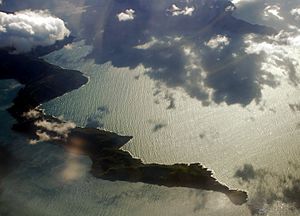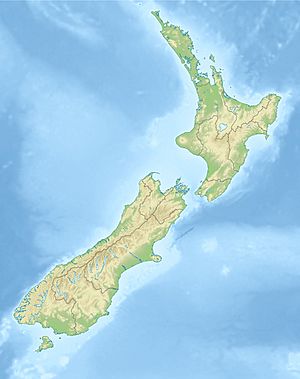Cape Jackson, New Zealand facts for kids
Quick facts for kids Cape Jackson |
|
|---|---|

Cape Jackson, Marlborough, New Zealand
|
|
| Location | Marlborough Sounds, Aotearoa New Zealand |
| Coordinates | 40°59′48″S 174°18′48″E / 40.9966°S 174.3134°E |
| Geology | Cape |
Cape Jackson (which in Māori is called Te Taonui-a-Kupe) is a piece of land that sticks out into the sea. It is located in the Marlborough area, on the South Island of Aotearoa New Zealand. This cape sits between two important waterways: Queen Charlotte Sound / Tōtaranui and Cook Strait.
Contents
What is Cape Jackson?
Cape Jackson is a type of landform called a peninsula. This means it is almost completely surrounded by water, but it is still connected to the mainland. The cape covers about 6 square kilometers (about 1,500 acres) of land.
History of the Cape
Over the years, Cape Jackson has been used for different things. In the past, people tried to find gold there. Later, it was used for farming sheep. More recently, the land has been used for something called carbon farming. This is when trees are grown specifically to soak up carbon dioxide from the air. This helps to fight climate change.
A Private Wilderness Park
Today, Cape Jackson is privately owned. The owners have turned the land into a special nature area called the Queen Charlotte Wilderness Park. This park is a place where native plants and animals can thrive. You can visit the park, but you need to arrange it with the owners first.
The Cliffs of Te Kupenga-a-Kupe
The tall cliffs along Cape Jackson have a special Māori name: Te Kupenga-a-Kupe. This name means "the fishing net of Kupe." The cliffs look like fishing nets that have been hung out to dry. According to an old legend, the famous Polynesian explorer Kupe left a fishing net here a very long time ago.
Bringing Back Native Bush
A lot of effort is being made to bring back the native forest that once covered Cape Jackson. This means planting many local trees and plants. The goal is to help the natural environment become healthy and strong again.
Naming the Cape
Cape Jackson has two important names, one from European explorers and one from Māori history.
European Name: Cape Jackson
The name Cape Jackson was given by Captain James Cook. He was a famous British explorer. On March 29, 1770, Cook named the cape after Sir George Jackson. Sir George was a friend and supporter of Cook, and he worked as a secretary for the British Admiralty.
Māori Name: Te Taonui-a-Kupe
The Māori name for this place is Te Taonui-a-Kupe. In the Māori language, this means "the large spear of Kupe". Kupe is a very important figure in Māori legends. He was a legendary Polynesian explorer who is said to have discovered New Zealand.



